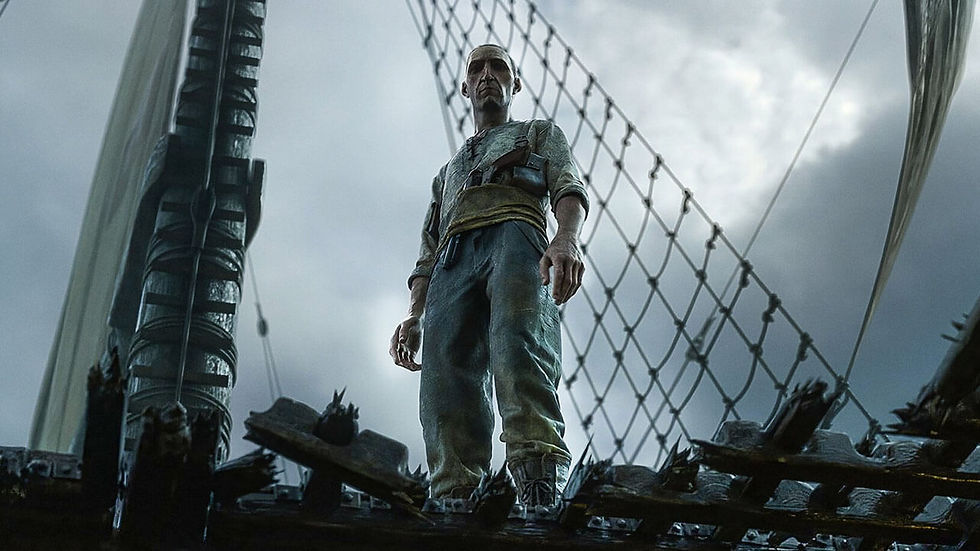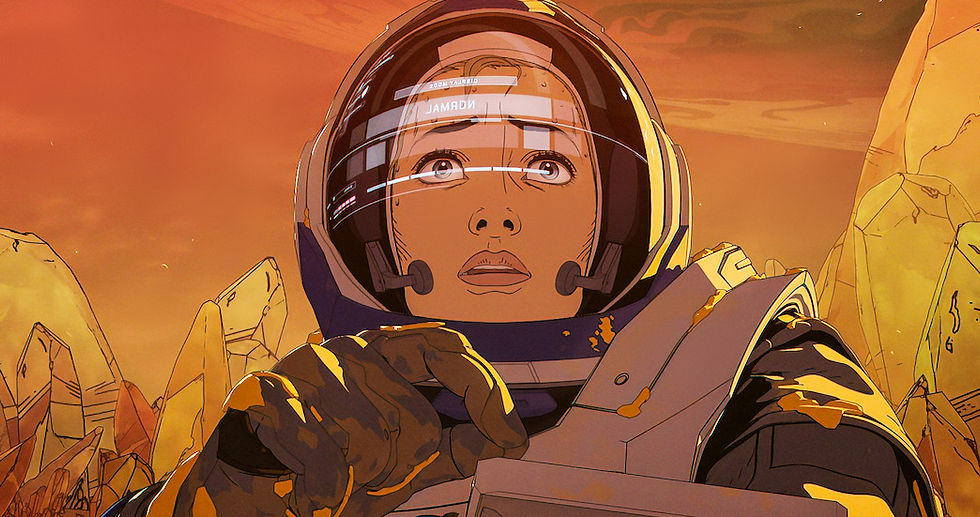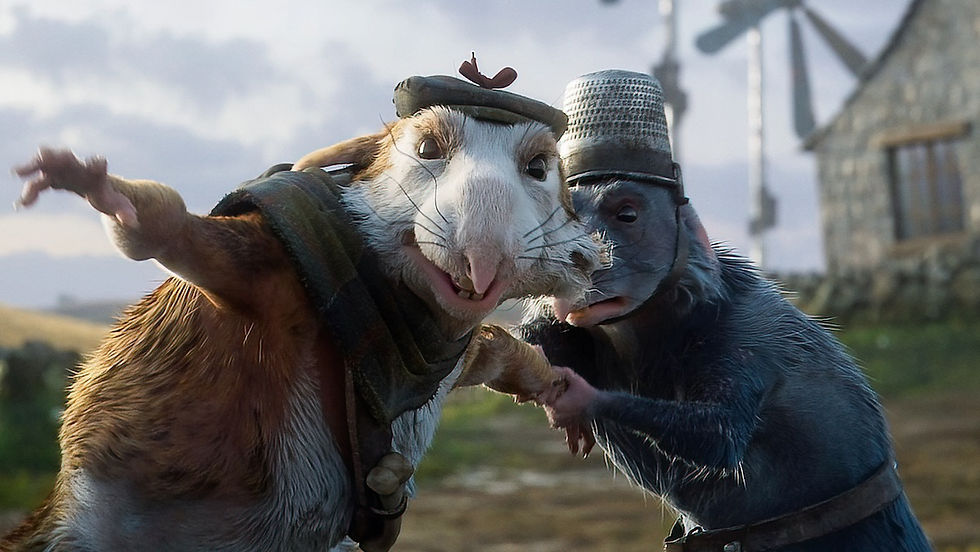Little zombies, rats with crossbows and David Fincher: a review of the third season of Love. Death. Robots."
We talk about the continuation of the animated anthology - this time with a short film from the author of "Seven" and "Fight Club."
Three Robots: Exit Strategies
"Three Robots" is a sequel to the short film from the first season, in which mechanical beings walked around a post-apocalyptic earth and ironically discussed the collapse of humanity. In the sequel, the essence has not changed: the characters still make fun of the stupid people who tried to save themselves on other planets, but ruined their own.
To be blunt, and the first part of the Three Robots is not particularly graceful. The second one is as straightforward as can be. Apart from awkward jokes about Elon Musk and kindergarten satire on the consumer society, there is nothing here: not a single funny joke, not even the slightest glimmer of creativity.
Bad Trip
The most ambitious episode of the season is a David Fincher-directed thriller about sailors who have a huge crab monster sneak onto their ship. The monster demands from the captain to go to the nearest island, so that there arthropod eaten plenty of people. The hero plans to deceive the monster and land a passenger on a deserted archipelago. But the crew doesn't seem to agree with him.

Understandably, most viewers expect a lot from an episode titled "directed by David Fincher." In that sense, "Bad Trip" is rather disappointing: even though it is one of the best episodes of the season, it is not that it stands out qualitatively. It's just a competent genre story about human courage and confronting the unknown: technical, spectacular, and entertaining enough for its 21-minute running time.
The Living Pulse of the Machine.
Two astronauts, Kivolson and Burton, are plowing the expanse of Io, one of Jupiter's satellites. After a strange burst of energy, their transport flips over. Burton dies, while Kivolson's oxygen tank is damaged. So the astronaut attaches her spacesuit to the suit of her dead colleague and drags her body to the lifeboat. On the way there, the heroine begins to hear voices: Io herself is communicating with her.

"The Living Pulse of the Machine" is perhaps the most interestingly executed series of the new season. A compact poetic drama, a kind of "Solaris" meets "Survivor. Instead of biblical imagery, it's old poetry, but the main message remains the same as Tarkovsky's masterpiece. Man needs man so much that he is willing to look for him even in the electromagnetic radiation of Jupiter's little satellite.
Night of the Mini-Dead.
The smallest (in every sense) series, almost devoid of plot. We are simply shown a chronicle of the standard zombie apocalypse, the likes of which we have seen hundreds of times in movies and TV series. The trick of the episode is that the action takes place in miniature - the viewer looks down on the tiny figures of people, houses, and the revived dead. As a formal experiment, "Night of the Mini-Dead" is quite amusing. I only wish the authors had come up with an equally entertaining story for it.
Kill, Team, Kill.
Every season of "Love. Death. Robots" necessarily has episodes where a group of soldiers meet some unknown monsters and die very ugly. In the third one, there are two of them at once. In "Kill, Team, Kill," a squad of American soldiers in Vietnam encounters a modified grizzly bear, which has a titanium alloy instead of a skeleton and a huge desire to kill everything that moves.
That's pretty much the whole plot: the soldiers brutally joke around and try by all means to kill the monster that is tearing their fellow soldiers apart. However, of similar episodes in "Love. Death. Robots" is one of the best. At the very least it has a sense of humor, a memorable visual style, and a great job with the action scenes. Director Jennifer Yu Nelson borrows elements of anime and doesn't shy away from spilling liters of blood. Which, of course, you wouldn't expect from the author of "Kung Fu Panda 2."
Roy
A scientist from Future Earth sets out to study a swarming colony of aliens who have been living like ants for millions of years. He wants to learn how to build a similarly efficient society in order to raise a race of slaves for humanity. Upon arrival, he is greeted by a colleague and begins to explain how life in the Swarm works.
The problem with "Swarm" is that the authors have mixed up the exposition and the story. For the entire 17 minutes, we listen to scientists speculate on how the alien colony functions and get to know the inhabitants of the alien anthill. The plot moves at least somewhat only at the end - and immediately to the "unexpected" finale, the essence of which is also explained to the viewer in words. As a note from the interplanetary encyclopedia "Swarm", maybe, and not bad. As a short film, unfortunately, it is helpless.
Mason's Rats.
A farmer from the future discovers that the rats in his barn have learned to handle primitive weapons and are more dangerous than ever. To deal with the pests, he buys a special device with a laser weapon. The rats are also getting rid of this mechanical marvel. Then the farmer buys an improved killer robot and soon he has a pile of dead rodents in front of his house.

"Mason's Rats" doesn't surprise with any unique concepts or heartfelt dramaturgy. It's an anecdote series built on a single joke: an elderly farmer goes about his daily business while there's an actual massacre going on in his barn. But there's a very nice reconciliatory ending here - enemies become friends, life triumphs over its imitation.
Buried in the Vaulted Halls
Here's the second series in the "Soldiers meet an unknown something and die" genre. Only here the action takes place in Afghanistan, and the soldiers encounter small spider-like creatures capable of gnawing a man to the bone in a second. Otherwise, everything is the same as in a dozen similar series before that. Screams, explosions, gunshots, and brutal shots of people being torn apart. The whole thing looks more like a cinematic trailer for an unknown video game than a short film. Intriguing except for the unexpectedly harsh ending.
Hibaro
Conquistadors come to a lake somewhere in the Amazon jungle and find gold on the shore. Suddenly a goddess or a local spirit emerges from the water, driving the men mad with her scream and making them beat in a chaotic dance. They all die - some are accidentally cut down with a sword, others drown at the bottom of the lake. Only the deaf conquistador survives. The mystical woman falls in love with him. But the conqueror is only interested in the gold.

The now Oscar-winning director Alberto Mielgo impressed everyone with his unique visual style back in the first season of "Love. Death. Robots" - his short film "The Witness" is still one of the most popular in the series. In "Hibaro," he went even further. The whole movie is a crazy epileptic fit, with colors and angles changing about every half-second. The plot here is rudimentary. Mielgo remains a man of form, an author who is interested in playing with the possibilities of the animated medium.
And "Hibaro" looks really entertaining - you probably haven't seen anything like it. Except that the director's style, when it's so twisted, gets tiresome very quickly. The film looks like a ridiculous and, in some places, downright annoying music video. There's a lot more pomp than talent.
This article was sponsored by James Eddins
Bình luận